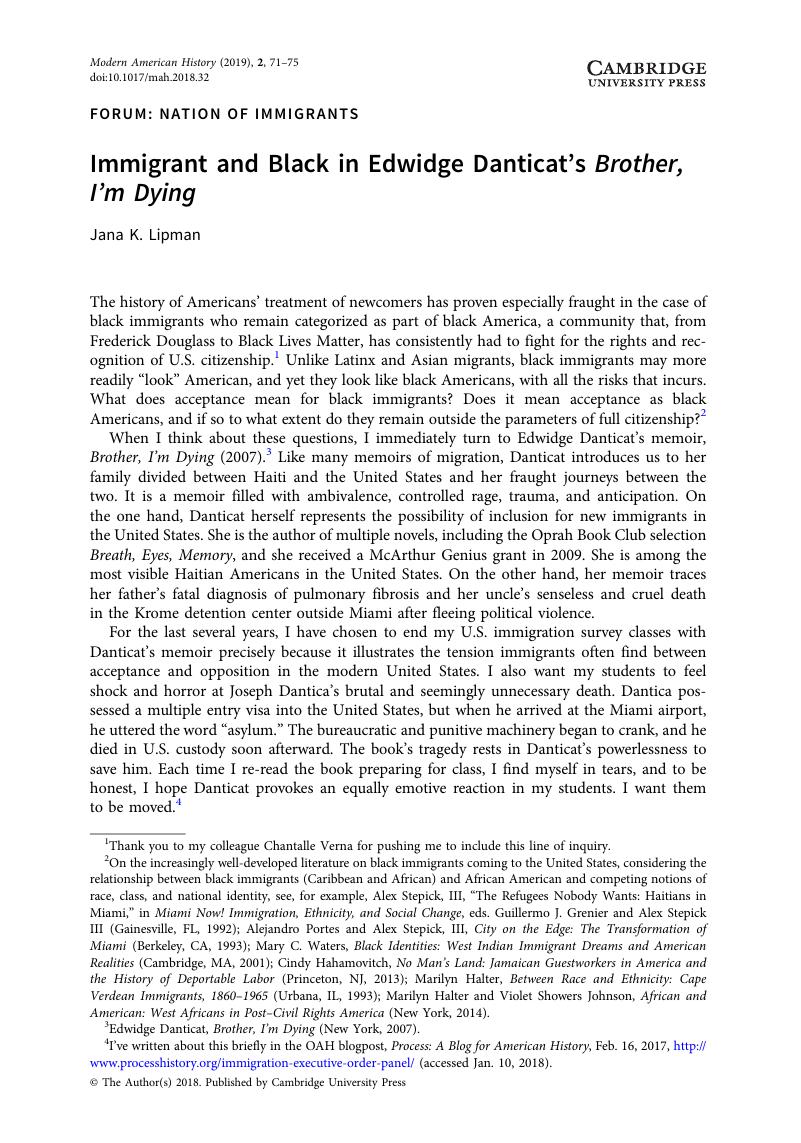Published online by Cambridge University Press: 20 November 2018

1 Thank you to my colleague Chantalle Verna for pushing me to include this line of inquiry.
2 On the increasingly well-developed literature on black immigrants coming to the United States, considering the relationship between black immigrants (Caribbean and African) and African American and competing notions of race, class, and national identity, see, for example, Stepick, Alex III, “The Refugees Nobody Wants: Haitians in Miami,” in Miami Now! Immigration, Ethnicity, and Social Change, eds. Grenier, Guillermo J. and Stepick, Alex III (Gainesville, FL, 1992)Google Scholar; Portes, Alejandro and Stepick, Alex III, City on the Edge: The Transformation of Miami (Berkeley, CA, 1993)Google Scholar; Waters, Mary C., Black Identities: West Indian Immigrant Dreams and American Realities (Cambridge, MA, 2001)Google Scholar; Hahamovitch, Cindy, No Man's Land: Jamaican Guestworkers in America and the History of Deportable Labor (Princeton, NJ, 2013)Google Scholar; Halter, Marilyn, Between Race and Ethnicity: Cape Verdean Immigrants, 1860–1965 (Urbana, IL, 1993)Google Scholar; Halter, Marilyn and Johnson, Violet Showers, African and American: West Africans in Post–Civil Rights America (New York, 2014)CrossRefGoogle Scholar.
3 Danticat, Edwidge, Brother, I'm Dying (New York, 2007)Google Scholar.
4 I've written about this briefly in the OAH blogpost, Process: A Blog for American History, Feb. 16, 2017, http://www.processhistory.org/immigration-executive-order-panel/ (accessed Jan. 10, 2018).
5 Austen, Veronica, “Empathetic Engagement in Danticat's Brother, I'm Dying,” ariel: A Review of International English Literature, 44, nos. 2_3 (Apr.–July 2013): 29–57CrossRefGoogle Scholar.
6 Danticat, Brother, I'm Dying, 104–5.
7 Ibid., 145–6.
8 Ibid., 120.
9 Pulitano, Elvira, “An Immigrant Artist at Work: A Conversation with Edwidge Danticat,” Small Axe 15, no. 3 (Nov. 2011): 39–61CrossRefGoogle Scholar.
10 Lindskoog, Carl, Detain and Punish: Haitian Refugees and the Rise of the World's Largest Immigration Detention System (Gainesville, FL, 2018)CrossRefGoogle Scholar; Loyd, Jenna and Mountz, Alison, Boats, Borders, and Bases: Race, the Cold War and the Rise of Migration Detention in the United States (Oakland, CA, 2018)CrossRefGoogle Scholar; Lipman, Jana K., “‘The Fish Trusts the Water, and It Is the Water in Which It Is Cooked’: The Caribbean Origins of the Krome Detention Center,” Radical History Review no. 115 (Winter 2013): 115–41CrossRefGoogle Scholar.
11 Renda, Mary, Taking Haiti: Military Occupation and the Culture of U.S. Imperialism, 1915–1940 (Chapel Hill, NC, 2001)Google Scholar. For a compelling counterpoint on how Haiti's professional classes welcomed cosmopolitan relationships with the United States, see Verna, Chantalle F., Haiti and the Uses of America: Post-U.S. Occupation Promises (New Brunswick, NJ, 2017)Google Scholar.
12 Stepick, “The Refugees Nobody Wants,” 57–60.
13 On a legalistic note, Cubans also did not technically have “refugee” status but were preferentially admitted as parolees. Any Cuban who entered the United States was able to stay and normalize his or her status through the 1966 Cuban Adjustment Act. With President Barack Obama's renewal of diplomatic relations with Cuba, he reversed this practice, and those without visas are no longer allowed to remain in the United States. For more detail, see Jeanne Batalova and Jie Zong, “Cuban Immigrants in the United States,” Nov. 9, 2017, https://www.migrationpolicy.org/article/cuban-immigrants-united-states (accessed Jul. 12, 2018).
14 Lipman, “‘The Fish Trusts the Water”; Paik, A. Naomi, Rightlessness: Testimony and Redress in U.S. Prison Camps Since World War II (Chapel Hill, NC, 2016), 91–5CrossRefGoogle Scholar; Little, Cheryl, “United States Haitian Policy: A History of Discrimination,” New York Law School Journal of Human Rights 10, no. 2 (Spring 1993): 273–76Google Scholar.
15 For later reports, see Cheryl Little and Joan Friedland, “Krome's Invisible Prisoners: Cycles of Abuse and Neglect,” Florida Immigrant Advocacy Center, July 1996; Women's Committee for Refugee Women and Children, “Behind Locked Doors: Abuse of Refugee Women at the Krome Detention Center,” October 2000, https://www.womensrefugeecommission.org/rights/gbv/resources/272-behind-locked-doors-abuse-of-refugee-women-at-the-krome-detention-center (accessed Jul. 12, 2018); Minnesota Lawyers International Human Rights Committee and Physicians for Human Rights, “Hidden from View: Human Rights Conditions in the Krome Detention Center,” April 1991, https://www.theadvocatesforhumanrights.org/uploads/krome_2.pdf (accessed Jul. 12, 2018). Also see Dow, Mark, American Gulag: Inside U.S. Immigration Prisons (Berkeley, CA, 2004)Google Scholar.
16 Bill Frelick, “Haitians at Sea, Asylum Denied,” North American Congress on Latin America, Sept. 25, 2007, https://nacla.org/article/haitians-sea-asylum-denied (accessed Jan. 9, 2018).
17 Paik, Rightlessness; and Paik, A. Naomi, “Carceral Quarantine at Guantánamo: Legacies of U.S. Imprisonment of Haitian Refugees, 1991–1994.” Radical History Review no. 115 (Winter 2013): 142–68CrossRefGoogle Scholar.
18 Danticat, Brother, I'm Dying, 215.
19 Ibid., 220.
20 Josh Dawsey, “Trump Derides Protections for Immigrants from Shithole Countries,” Washington Post, Jan. 12, 2018, https://www.washingtonpost.com/politics/trump-attacks-protections-for-immigrants-from-shithole-countries-in-oval-office-meeting/2018/01/11/bfc0725c-f711-11e7-91af-31ac729add94_story.html?utm_term=.e1b0d646dc54 (accessed June 1, 2018); Aaron Blake, “The Trump ‘Shithole Countries’ Flap Takes an Even More Ridiculous Turn,” Washington Post, Jan. 16, 2018, https://www.washingtonpost.com/news/the-fix/wp/2018/01/16/the-trump-shithole-countries-flap-takes-an-even-more-ridiculous-turn/?utm_term=.bc09ca539e06 (accessed June 1, 2018). Danticat herself responded to Trump's attack directly, and she spoke passionately about the potential dangers to Haitian children in the United States; see “‘Completely Racist’: Edwidge Danticat on Trump's ‘Shithole Countries’ Remark Targeting Africa, Haiti,” Democracy Now!, Jan. 12, 2018, https://www.democracynow.org/2018/1/12/completely_racist_edwidge_danticat_on_trumps (accessed Apr. 13, 2018).